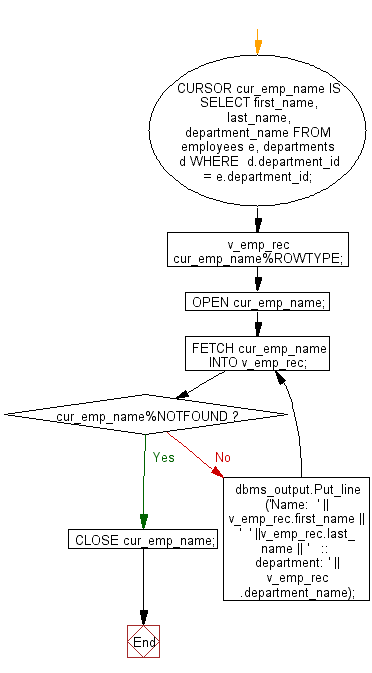PL/SQL Cursor Exercises: FETCH multiple records and more than one columns from different tables
PL/SQL Cursor: Exercise-18 with Solution
Write a program in PL/SQL to FETCH multiple records and more than one columns from different tables.
Below example we are trying to fetch department names and employee names.
Sample Solution:
PL/SQL Code:
DECLARE
CURSOR cur_emp_name IS
SELECT first_name,
last_name,
department_name
FROM employees e,
departments d
WHERE d.department_id = e.department_id;
v_emp_rec cur_emp_name%ROWTYPE;
BEGIN
OPEN cur_emp_name;
LOOP
FETCH cur_emp_name INTO v_emp_rec;
exit WHEN cur_emp_name%NOTFOUND;
dbms_output.Put_line('Name: '
|| v_emp_rec.first_name
|| ' '
||v_emp_rec.last_name
|| ' :: department: '
|| v_emp_rec.department_name);
END LOOP;
CLOSE cur_emp_name;
END;
/
Sample Output:
SQL> / Name: Jennifer Whalen :: department: Administration Name: Pat Fay :: department: Marketing Name: Michael Hartstein :: department: Marketing Name: Sigal Tobias :: department: Purchasing Name: Karen Colmenares :: department: Purchasing Name: Shelli Baida :: department: Purchasing Name: Den Raphaely :: department: Purchasing Name: Alexander Khoo :: department: Purchasing Name: Guy Himuro :: department: Purchasing Name: Susan Mavris :: department: Human Resources Name: Kevin Feeney :: department: Shipping Name: Jean Fleaur :: department: Shipping Name: Adam Fripp :: department: Shipping ...
Flowchart:

Improve this sample solution and post your code through Disqus
Previous: Write a program in PL/SQL to FETCH multiple records and more than one columns from the same table.
Next: Write a program in PL/SQL to FETCH multiple records with the uses of nested cursor.
What is the difficulty level of this exercise?
- New Content published on w3resource:
- HTML-CSS Practical: Exercises, Practice, Solution
- Java Regular Expression: Exercises, Practice, Solution
- Scala Programming Exercises, Practice, Solution
- Python Itertools exercises
- Python Numpy exercises
- Python GeoPy Package exercises
- Python Pandas exercises
- Python nltk exercises
- Python BeautifulSoup exercises
- Form Template
- Composer - PHP Package Manager
- PHPUnit - PHP Testing
- Laravel - PHP Framework
- Angular - JavaScript Framework
- Vue - JavaScript Framework
- Jest - JavaScript Testing Framework
